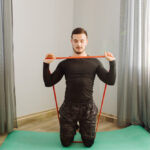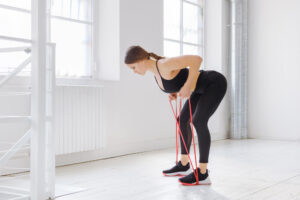Is walking really cardio, or is it just a way to get some fresh air? When we think of cardio, we usually think of high-energy activities like running, cycling, or those intense HIIT sessions that leave us breathless. Walking, on the other hand, seems too relaxing. But, is that really the case? Let’s see.
What makes a workout “Cardio”?
The goal of cardio exercises is to get your heart pumping and your lungs working. It involves any activity that raises your heart rate and keeps it elevated for an extended period. The goal? To strengthen your heart and improve circulation, making it easier for your body to deliver oxygen to muscles and organs.
When we talk about “cardio,” we’re referring to aerobic exercise. Activities like jogging, swimming, and dancing will get your blood moving and boost endurance for sure. But not all cardio is created equal. The key factors that determine whether an exercise is truly cardiovascular include:
- Intensity: Cardio typically involves working at a moderate to vigorous pace that raises your heart rate. That’s why you can feel your heart thumping after a run or a spin class.
- Duration: Cardio isn’t about short bursts. It’s about maintaining that increased heart rate over time, usually 20-60 minutes per session.
- Consistency: For real benefits, you need to do it regularly, aiming for 150 minutes of moderate-intensity cardio per week, as recommended by most health guidelines.
Walking as a cardio workout: Benefits and limitations
So can you count walking as cardio? Absolutely! Especially if you’re looking for a low-impact way to stay active. Here’s why walking can be an effective form of cardio, along with some of its drawbacks.
Low-intensity cardio
Walking is considered a low-intensity cardio exercise. It doesn’t push your heart rate up as much as running or aerobics, but it’s easier on your joints and accessible to nearly everyone. This makes it a great starting point for those new to exercise or looking to get back into shape without risking injury.
Health Benefits
- Cardiovascular health: Even a brisk walk can boost circulation, lower blood pressure, and help keep your heart in good shape. A study shows that regular walking can reduce the risk of heart disease just as effectively as more intense workouts.
- Mental health boost: Walking isn’t just good for your heart, it’s great for your mind too. The rhythmic nature of walking helps reduce stress, improve mood, and even sharpen focus. Think of it as a workout for both body and mind.
- Weight management: While walking doesn’t burn calories as fast as a sprint, it can still be part of a weight loss plan. Over time, the calories burned from walking add up, especially if you walk regularly and combine it with a balanced diet.
Limitations
- Caloric burn: A stroll around the neighborhood won’t burn as many calories as a run, especially if you keep a leisurely pace.
- Building endurance: If you’re training for a marathon or looking to build serious endurance, walking alone won’t get you there. You’ll need to integrate more intense forms of cardio for bigger gains in stamina.
Best for beginners
Walking can be a perfect starting point for anyone who feels overwhelmed by the thought of jumping into a high-intensity routine. It’s a low-barrier way to get moving, making it easier to build consistency and create a habit of exercise.
How to burn more calories while walking?
To burn more calories while walking, here are a few things you can try:
- Power walking: Think of power walking as walking with a purpose. Brisk pace, arms swinging, and focused posture. This type of walking can raise your heart rate significantly more than a casual stroll. Aim for a pace where you can still talk, but you’d rather not.
- Incline walking: Walking uphill or on an incline, whether outdoors or on a treadmill, can quickly turn up the intensity. The steeper the incline, the harder your heart and lungs have to work, making this an excellent way to boost your cardio benefits.
- Weighted walking: Adding light weights, like a pair of dumbbells or a weighted vest, can add resistance to your walking routine. This increased effort can push your heart rate up, making it more of a cardio challenge. Just be mindful of your posture to avoid straining your back or joints.
- Interval walking: If you’re ready to mix things up, try alternating between fast-paced walking and a more relaxed pace. This technique, known as interval walking, can mimic the effects of high-intensity interval training (HIIT) but with lower impact, making it a great option for a range of fitness levels.
Walking vs. traditional cardio workouts
How does walking really stack up against the big players of cardio, like running or cycling? Let’s take a look at how walking compares to more intense forms of cardiovascular exercise.
Intensity comparison
Walking is undoubtedly lower in intensity than running or spinning. While a brisk walk might get your heart rate up to around 50-60% of your maximum heart rate, a run can push that number much higher. For those looking to get a serious sweat on, walking might not feel challenging enough.
Heart rate differences
When it comes to elevating heart rate, traditional cardio workouts like running, HIIT, and cycling take the lead. These activities can help you reach 70-85% of your maximum heart rate, which is the sweet spot for improving cardiovascular fitness. Walking, particularly at a slower pace, typically lands in the moderate-intensity range.
When walking is enough
But that doesn’t mean walking doesn’t have its place. For beginners, older adults, or those with joint concerns, walking can be more than enough to reap the health benefits of cardio. Even for seasoned athletes, walking can serve as a recovery workout that keeps the body moving without overdoing it.
Other great low-intensity cardio options
Here are a few other low-intensity cardio exercises that can give you variety while keeping things easy on your joints:
- Cycling: Riding a bike, whether outdoors or on a stationary bike, is an effective way to elevate your heart rate without a heavy impact on your body. Cycling allows you to control the pace and resistance, making it adaptable for any fitness level. Plus, it’s a fun way to explore new places if you’re biking outside!
- Swimming: If you have access to a pool, swimming is one of the best full-body, low-impact cardio options. The water provides natural resistance while supporting your body weight, making it gentle on your joints. Swimming laps or even water aerobics can improve cardiovascular health, build endurance, and increase strength.
- Elliptical training: The elliptical machine mimics walking and running motions without impact, which is especially helpful for those with knee or joint issues. You can adjust the resistance and incline to add intensity as needed. Elliptical training is also great for working both the upper and lower body, thanks to the moving handles.
- Rowing: Rowing is a low-intensity cardio option that also doubles as a strength workout, especially for your upper body and core. Whether you’re using a rowing machine or rowing on the water, this workout allows you to control your pace and resistance while offering a solid aerobic workout.
- Dancing: Who says cardio can’t be fun? Low-intensity dance classes, like Zumba or even casual at-home dance sessions, are a great way to get your heart rate up without feeling like you’re “exercising.” Dancing improves coordination, flexibility, and balance, and it’s easy to adjust the intensity to suit your energy level.
Final thoughts
While it may not replace high-intensity workouts for those seeking a major calorie burn or intense conditioning, walking still holds a valuable spot in any fitness routine. It’s perfect for beginners, those recovering from injuries, or anyone looking for a way to stay active without the stress of a high-impact workout.







